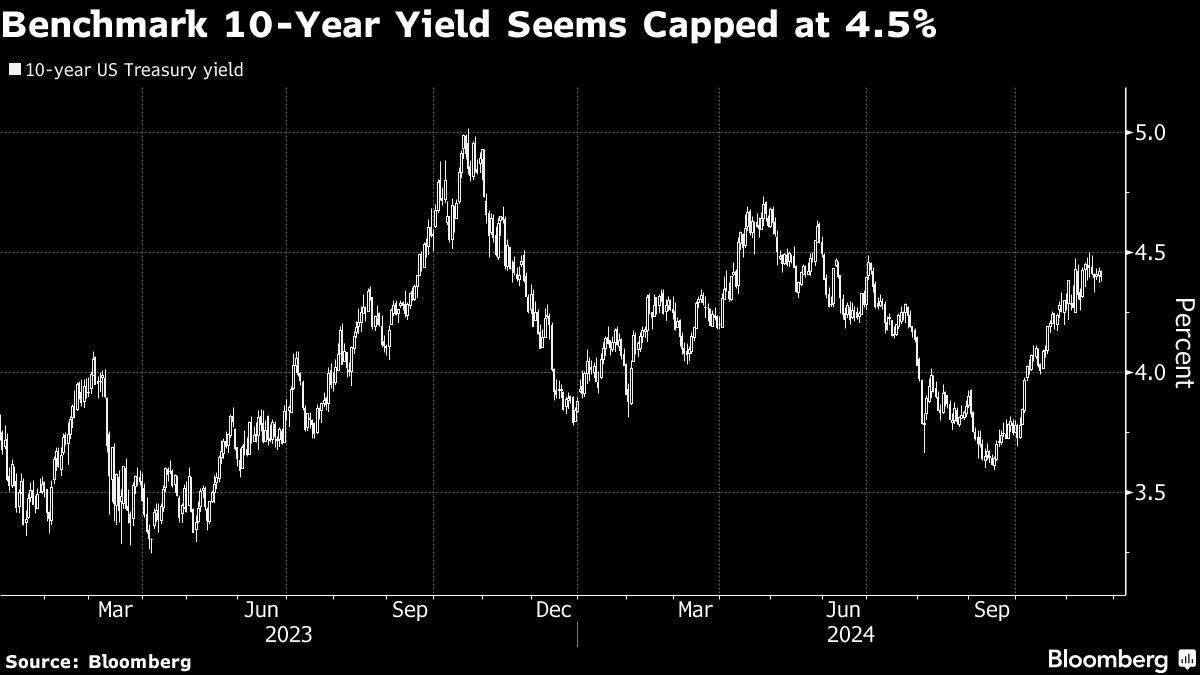
(Bloomberg) — The US bond market is finally showing signs of steadying after a two-month selloff, with investors starting to swoop in whenever yields test new peaks.
Most Read from Bloomberg
Donald Trump’s presidential victory, stubbornly elevated inflation and a steady drumbeat of strong economic data have pushed 10-year Treasury yields up sharply since mid-September — and there’s no clear consensus of where they’re likely to go.
But after the global benchmark topped 4.5% on Nov. 15, it quickly reversed course amid a wave of large purchases and hasn’t breached that level since. Ten-year yields closed on Friday at 4.4%, down 3 basis points versus the prior week’s close.
Fund managers at Pacific Investment Management Co. said Treasury yields at well over 4% are attractive on their own. But with federal government debt also now generally moving in the opposite direction as stock prices, it has also started to take on its traditional role as a hedge against an equity market slide.
Treasuries are “a very low volatility asset with a high return,” Pimco’s Erin Browne said in a Bloomberg Television interview, adding that if the 10-year yield rose back to 5% she would “really get interested in buying more aggressively.”
The last two months mark another turbulent shift for the bond market, which has defied expectations that it would rally once the Fed started cutting interest rates. Instead, since the central bank’s first move in September, yields have pushed higher as the strong economy and Trump’s victory drove traders to recalibrate how far it would go.
Trump on Friday nominated Scott Bessent, who runs macro hedge fund Key Square Group, as the next US Treasury secretary after an extended search that included multiple high profile candidates. Bessent, seen by some in Wall Street as a ‘fiscal hawk’, will play a key role in overseeing the government’s hefty debt sales.
Bessent has questioned President Joe Biden’s administration management of federal debt financing and has criticized the US central bank for its large interest-rate cut in September.
“I don’t think investors have a strong conviction for much higher yields, but at the same time there’s some resistance for a meaningful rally,” said Subadra Rajappa, head of US rates strategy at Societe Generale. “Investors are playing it safe, not taking any positions.”
With uncertainties over Trump administration tariffs and fiscal stimulus, “it’s more of take a pause and understand the dynamics” for the market, Rajappa said.
Felipe Villarroel, a portfolio manager at TwentyFour Asset Management, sees 4.25% to 4.5% as fair value for the 10-year, but adds that “there will be continued volatility” given “the inflation picture hasn’t deteriorated as much recently” and investors don’t know whether Trump policies will fuel price growth.
While swaps traders see a slightly less than 50-50 chance the central bank cuts rates at their meeting next month, they are pricing in about 66 basis points of total reduction by December 2025.
What Bloomberg Strategists Say …
“Ten-year yields are rotating around 4.40%. Yields are unlikely to break free until there are more catalysts. One key driver might be an answer to the question of who heads the US coffers.”
Alyce Andres, US rates/FX strategist
Read full report, here
But some strategists said that the 10-year yield has room to push higher, potentially hitting the 5% mark last seen in October 2023, if Trump sharply cuts taxes and boosts tariffs. And trading in debt options show wagers hedging against risk that yields will break out higher, so more upsides isn’t being completely written off.
This week, traders will get new insights with the release Wednesday of the Fed’s preferred inflation measure — the personal consumption expenditure price index. With that report coming the day before markets are closed on Thursday for the US Thanksgiving holiday — and an early market close the following day — thin trading volume may spark outsized price swings if the reading is well beyond consensus forecasts.
What to Watch:
-
Economic data:
-
Nov. 25: Chicago Fed national activity; Dallas Fed manufacturing activity
-
Nov. 26: Philadelphia Fed non-manufacturing; FHFA house price index; Q3 housing purchase index; S&P CoreLogic 20-City home prices; New home sales; Conference Board consumer confidence; Richmond Fed manufacturing index and business conditions; Dallas Fed services activity; Fed minutes
-
Nov. 27: MBA mortgage applications; Q3 GDP (second reading); Advance goods trade balance; wholesale/retail inventories; durable goods; initial jobless claims; MNI Chicago PMI; Personal income and spending; PCE price index; pending home sales
-
Nov. 28: Thanksgiving holiday
-
-
Auction calendar:
-
Nov. 25: 13-, 26-week bills; 3-day CMB; 2-year notes
-
Nov. 26: 52-week bills; 41-day CMB; 2-year FRN reopening; 5-year notes
-
Nov. 27: 4-, 8-, 17-week bills; 7-year notes
-
–With assistance from Edward Bolingbroke.
Most Read from Bloomberg Businessweek
©2024 Bloomberg L.P.
EMEA Tribune is not involved in this news article, it is taken from our partners and or from the News Agencies. Copyright and Credit go to the News Agencies, email news@emeatribune.com Follow our WhatsApp verified Channel




